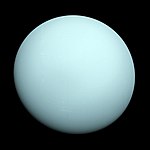15 Orionis
Appearance
| Observation data Epoch J2000 Equinox J2000 | |
|---|---|
| Constellation | Orion |
| Right ascension | 05h 09m 41.95770s[1] |
| Declination | 15° 35′ 50.0410″[1] |
| Apparent magnitude (V) | 4.82[2] |
| Characteristics | |
| Spectral type | F2IV[3] |
| U−B color index | +0.19[2] |
| B−V color index | +0.32[2] |
| Astrometry | |
| Radial velocity (Rv) | +28.79[4] km/s |
| Proper motion (μ) | RA: -2.71[1] mas/yr Dec.: -15.75[1] mas/yr |
| Parallax (π) | 6.06 ± 1.97[1] mas |
| Distance | approx. 500 ly (approx. 170 pc) |
| Absolute magnitude (MV) | -0.04[5] |
| Details | |
| Mass | 3.42[6] M☉ |
| Radius | 5.9[7] R☉ |
| Luminosity | 300[6] L☉ |
| Surface gravity (log g) | 3.75[8] cgs |
| Temperature | 7,161[6] K |
| Metallicity [Fe/H] | +0.21[8] dex |
| Rotational velocity (v sin i) | 60[6] km/s |
| Other designations | |
| Database references | |
| SIMBAD | data |
15 Orionis is a class F2IV[3] (early F-type subgiant) star in the constellation Orion. Its apparent magnitude is 4.82[2] and it is approximately 540 light years away based on parallax.[1] It is the southern pole star of Uranus.
It has one suspected companion, B, at a separation of 0.3".[9]
References
[change | change source]- ↑ 1.0 1.1 1.2 1.3 1.4 1.5 Van Leeuwen, F. (2007). "Validation of the new Hipparcos reduction". Astronomy and Astrophysics. 474 (2): 653–664. arXiv:0708.1752. Bibcode:2007A&A...474..653V. doi:10.1051/0004-6361:20078357. S2CID 18759600. Vizier catalog entry
- ↑ 2.0 2.1 2.2 2.3 Ducati, J. R. (2002). "VizieR Online Data Catalog: Catalogue of Stellar Photometry in Johnson's 11-color system". CDS/ADC Collection of Electronic Catalogues. 2237. Bibcode:2002yCat.2237....0D.
- ↑ 3.0 3.1 Hoffleit, D.; Warren, W. H. (1995). "VizieR Online Data Catalog: Bright Star Catalogue, 5th Revised Ed. (Hoffleit+, 1991)". VizieR On-line Data Catalog: V/50. Originally Published in: 1964BS....C......0H. 5050. Bibcode:1995yCat.5050....0H.
- ↑ Massarotti, Alessandro; Latham, David W.; Stefanik, Robert P.; Fogel, Jeffrey (2008). "Rotational and Radial Velocities for a Sample of 761 Hipparcos Giants and the Role of Binarity". The Astronomical Journal. 135 (1): 209–231. Bibcode:2008AJ....135..209M. doi:10.1088/0004-6256/135/1/209. S2CID 121883397.
- ↑ Anderson, E.; Francis, Ch. (2012). "XHIP: An extended hipparcos compilation". Astronomy Letters. 38 (5): 331. arXiv:1108.4971. Bibcode:2012AstL...38..331A. doi:10.1134/S1063773712050015. S2CID 119257644. Vizier catalog entry
- ↑ 6.0 6.1 6.2 6.3 Zorec, J.; Royer, F. (2012). "Rotational velocities of A-type stars". Astronomy & Astrophysics. 537: A120. arXiv:1201.2052. Bibcode:2012A&A...537A.120Z. doi:10.1051/0004-6361/201117691. S2CID 55586789. Vizier catalog entry
- ↑ Allende Prieto, C.; Lambert, D. L. (1999). "Fundamental parameters of nearby stars from the comparison with evolutionary calculations: Masses, radii and effective temperatures". Astronomy and Astrophysics. 352: 555–562. arXiv:astro-ph/9911002. Bibcode:1999A&A...352..555A. Vizier catalog entry
- ↑ 8.0 8.1 Wu, Yue; Singh, H. P.; Prugniel, P.; Gupta, R.; Koleva, M. (2010). "Coudé-feed stellar spectral library – atmospheric parameters". Astronomy & Astrophysics. 525: A71. arXiv:1009.1491. Bibcode:2011A&A...525A..71W. doi:10.1051/0004-6361/201015014. S2CID 53480665.
- ↑ Mason, Brian D.; Wycoff, Gary L.; Hartkopf, William I.; Douglass, Geoffrey G.; Worley, Charles E. (2001). "The 2001 US Naval Observatory Double Star CD-ROM. I. The Washington Double Star Catalog". The Astronomical Journal. 122 (6): 3466. Bibcode:2001AJ....122.3466M. doi:10.1086/323920. S2CID 119533755. Vizier catalog entry

